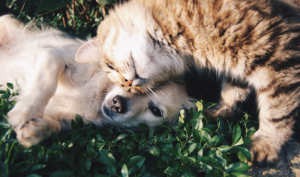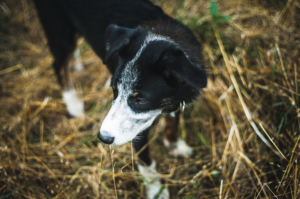
The Ultimate Guide to Owning a Blue Heeler and Aussie Mix: Everything You Need to Know!
The Blue Heeler and Aussie Mix, also known as the Australian Cattle Dog and Australian Shepherd Mix, is a popular breed that combines the best traits of both parent breeds. This mix is known for its intelligence, loyalty, and versatility, making it a great choice for active individuals or families. In this article, we will explore the history, physical characteristics, personality traits, training and socialization needs, exercise requirements, nutrition and health considerations, grooming and coat care, common behavioral issues and solutions, as well as tips for finding and choosing the right Blue Heeler and Aussie Mix for you.
History and Origins of the Blue Heeler and Aussie Mix
The Blue Heeler, also known as the Australian Cattle Dog, originated in Australia in the 19th century. They were bred to handle herding cattle in harsh conditions. The Australian Shepherd, on the other hand, has a slightly different history. Despite its name, it did not originate in Australia but rather in the United States. The breed was developed to work on ranches and farms herding livestock.
The Blue Heeler and Aussie Mix came to be through intentional breeding between these two breeds. The goal was to create a dog that possessed the herding instincts and working abilities of both parent breeds. This mix has become increasingly popular due to its intelligence, agility, and versatility. They excel in various activities such as herding trials, obedience competitions, agility courses, and even as therapy dogs.
Physical Characteristics and Appearance of the Blue Heeler and Aussie Mix
The Blue Heeler and Aussie Mix is a medium-sized dog with a sturdy build. They typically weigh between 35 to 60 pounds and stand around 17 to 23 inches tall at the shoulder. Their coat can come in a variety of colors including blue merle, red merle, black, or red, often with white markings.
One of the most striking physical features of this mix is their eyes. They often have captivating, almond-shaped eyes that can be blue, brown, or a combination of both. Their ears are usually medium-sized and can be either erect or semi-erect.
Personality Traits and Temperament of the Blue Heeler and Aussie Mix
The Blue Heeler and Aussie Mix is known for its intelligence, loyalty, and high energy levels. They are highly trainable and eager to please their owners. This mix is often described as being alert, protective, and hardworking. They have a strong herding instinct and may try to herd family members or other pets.
While both parent breeds are generally friendly and good-natured, the mix’s personality may vary depending on the individual dog. Some may inherit more of the Blue Heeler’s protective nature, while others may have a more laid-back temperament like the Australian Shepherd. Early socialization and training are crucial to ensure a well-rounded and well-behaved dog.
It’s important to note that this mix can be prone to certain behavioral tendencies such as nipping or herding children or other animals. This can be managed through proper training and redirection of their herding instincts towards appropriate activities.
Training and Socialization for the Blue Heeler and Aussie Mix
Training and socialization are essential for the Blue Heeler and Aussie Mix due to their high intelligence and energy levels. Early training should focus on basic obedience commands such as sit, stay, come, and leash walking. Positive reinforcement techniques work best with this breed, as they respond well to praise, treats, and play rewards.
Socialization is equally important to ensure that the mix is comfortable around people, other animals, and different environments. Exposing them to various sights, sounds, smells, and experiences from a young age will help them become well-adjusted adults. It’s important to note that this mix may have a strong herding instinct, so proper socialization can help prevent any unwanted herding behaviors.
Exercise and Activity Requirements for the Blue Heeler and Aussie Mix
The Blue Heeler and Aussie Mix is an active breed that requires plenty of exercise and mental stimulation to thrive. They are not well-suited for apartment living and do best in homes with a large, securely fenced yard where they can run and play.
Daily exercise should include long walks, runs, or hikes, as well as interactive play sessions. This mix also excels in various dog sports such as agility, obedience, and herding trials. Mental stimulation is equally important, as this breed is highly intelligent and needs tasks to keep their minds occupied. Puzzle toys, obedience training, and interactive games can help fulfill their mental needs.
Nutrition and Health Considerations for the Blue Heeler and Aussie Mix
Feeding a balanced diet is crucial for the overall health and well-being of the Blue Heeler and Aussie Mix. High-quality dog food that is appropriate for their age, size, and activity level should be provided. It’s important to consult with a veterinarian to determine the right amount of food to feed your dog.
Like any breed, the Blue Heeler and Aussie Mix can be prone to certain health issues. Some common health concerns include hip dysplasia, progressive retinal atrophy (PRA), deafness, and epilepsy. Regular veterinary check-ups, a nutritious diet, regular exercise, crucial problems, and proper grooming can help keep them healthy.
Grooming and Coat Care for the Blue Heeler and Aussie Mix
The Blue Heeler and Aussie Mix has a medium-length double coat that requires regular grooming to keep it in good condition. They have a dense undercoat that helps protect them from harsh weather conditions. Regular brushing will help remove loose hair and prevent matting.
This mix is a moderate shedder and may require more frequent brushing during shedding seasons. Bathing should be done as needed, typically every few months or when they get dirty. It’s important to check their ears regularly for any signs of infection and to trim their nails regularly.
Common Behavioral Issues and Solutions for the Blue Heeler and Aussie Mix
Like any breed, the Blue Heeler and Aussie Mix can be prone to certain behavioral issues. Separation anxiety is a common problem, as this mix forms strong bonds with their owners and may become anxious when left alone for long periods. Crate training, providing mental stimulation toys, and gradually increasing alone time can help alleviate separation anxiety.
Aggression towards other dogs can also be an issue, especially if not properly socialized from a young age. Early socialization and positive reinforcement training can help prevent or manage aggressive behaviors towards other dogs. Destructive behavior can also occur if the mix is not provided with enough mental stimulation and exercise. Ensuring they have plenty of toys, exercise, and mental enrichment activities can help prevent destructive behaviors.
Finding and Choosing the Right Blue Heeler and Aussie Mix for You
When looking for a Blue Heeler and Aussie Mix, it’s important to find a reputable breeder who prioritizes the health and temperament of their dogs. Ask the breeder about health clearances for both parent breeds and spend time with the puppies to assess their temperament.
Consider your lifestyle and activity level when choosing a puppy. Some individuals may have higher energy levels or stronger herding instincts than others. It’s important to choose a puppy that matches your lifestyle and activity level to ensure a harmonious relationship.
Enjoying Life with Your Blue Heeler and Aussie Mix
The Blue Heeler and Aussie Mix is a wonderful breed that combines the best traits of both parent breeds. With their intelligence, loyalty, and versatility, they make excellent companions for active individuals or families. By understanding their history, physical characteristics, personality traits, training and socialization needs, exercise requirements, nutrition and health considerations, grooming and coat care, common behavioral issues and solutions, as well as tips for finding and choosing the right Blue Heeler and Aussie Mix for you, you can ensure a happy and fulfilling life with your new furry friend.





